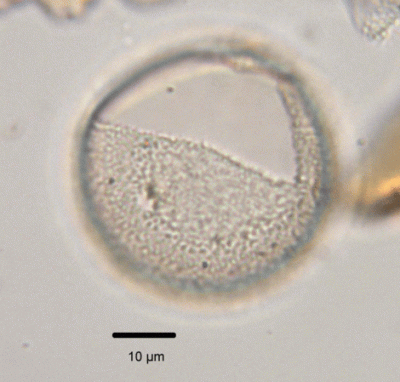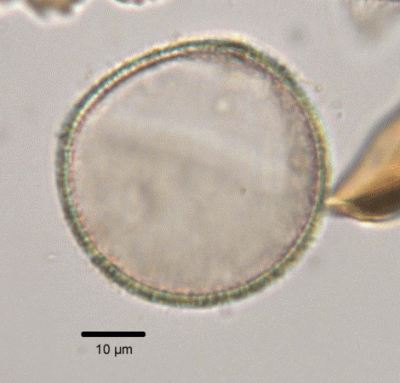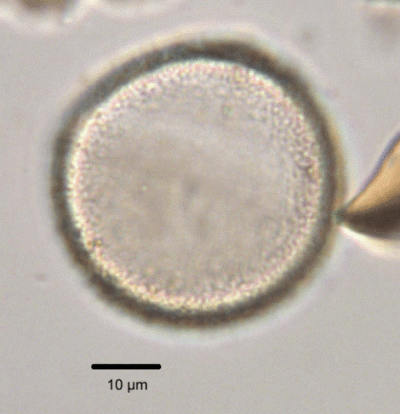Page path:
- Modern Dinocyst Key
- transparent cysts
- no septa, no processes
- Bitectatodinium tepikiense
Bitectatodinium tepikiense
Zonneveld, K.A.F. and Pospelova V. (2015). A determination key for modern dinoflagellate cysts. Palynology 39 (3), 387- 407.



dorsal view
cross section
ventral view
Field characteristics
Bitectatodinium tepikiense Wilson 1973
Field characteristics:
Subspherical cyst with a cell wall that consist of a spongy microreticulate layer of a dense formation of lamellae. Archeopyle is precingular (type 2P). No other indication of tabulation present. .
Dimensions: Cyst body diameter: 46–60 µm; wall thickness: 2–4 µm.
Motile affinity: Probably a cyst of Gonyaulax spp.
Cyst-theca relationship: Dale, 1976
Stratigraphic range: Upper Miocene to Recent.
Comparison with other species:
The distinctive characters of these cysts are the archeopyle; the loss of two precingular plates and the cyst wall. The wall, consist of a microreticulate layer that comprises erect or suberect lamellae that are sometimes branched and often arise from raised bases (for details see (Head, 1994). The appearance looks a little like the inner body of a Gymnosperm pollen grain. The difference is that the wall of the Gymnosperm is of irregular height and consist of a double wall connected by columellae. The outer layer of B. tepikiense might have a sort of furry appearance. The cysts are often folded or broken and the archeopyle is oft difficult to distinguish.
Field characteristics:
Subspherical cyst with a cell wall that consist of a spongy microreticulate layer of a dense formation of lamellae. Archeopyle is precingular (type 2P). No other indication of tabulation present. .
Dimensions: Cyst body diameter: 46–60 µm; wall thickness: 2–4 µm.
Motile affinity: Probably a cyst of Gonyaulax spp.
Cyst-theca relationship: Dale, 1976
Stratigraphic range: Upper Miocene to Recent.
Comparison with other species:
The distinctive characters of these cysts are the archeopyle; the loss of two precingular plates and the cyst wall. The wall, consist of a microreticulate layer that comprises erect or suberect lamellae that are sometimes branched and often arise from raised bases (for details see (Head, 1994). The appearance looks a little like the inner body of a Gymnosperm pollen grain. The difference is that the wall of the Gymnosperm is of irregular height and consist of a double wall connected by columellae. The outer layer of B. tepikiense might have a sort of furry appearance. The cysts are often folded or broken and the archeopyle is oft difficult to distinguish.
Geographic distribution based on :
Zonneveld et al., 2013. Atlas of modern dinoflagellate cyst distribution based on 2405 datapoints. Review of Palaeobotany and Palynology, v. 191, 1-197
Zonneveld et al., 2013. Atlas of modern dinoflagellate cyst distribution based on 2405 datapoints. Review of Palaeobotany and Palynology, v. 191, 1-197
Bitectatodinium tepikiense has a restricted bipolar distribution and can be found in sub-polar and temperate regions generally between the sub-tropical and arctic frontal systems on both hemispheres. It occurs in both eutrophic and oligotrophic environments in regions where bottom waters are well ventilated.

Distribution:
B. tepikiense is restricted to sub-polar and temperate areas of both hemispheres with highest abundances in the North Sea, off eastern Canada and off Argentina near the subtropical front.
Environmental parameter range:
SST: -2.0 - 26.9°C (winter - summer), SSS: 17.4 - 39.3 (spring - autumn), [P]: 0.1 - 1.8 μmol/l, [N]: 0.07 - 23.3 μmol/l, chlorophyll-a: 0.08 - 20.8 ml/l, bottom water [O2]: > 1.7 ml/l.
Abundances >10% are observed in regions where SST ranges between -0.2 - 26.9°C (winter - summer). It is exclusively registered in regions where SSS > 25.6 (summer) except for a site in the East Siberian Sea (Arctic Ocean) where SSS ranges between 17.4 and 19.0 (spring - summer). Abundances >10% are observed in regions where SSS > 30.3 (spring).
Cysts have been reported from oligotrophic to eutrophic environments whereby the majority of the observations and abundances >10% occur in oligotrophic to mesotrophic environments with [P]: < 0.6 μmol/l and [N]: < 3.3 μmol/l. It is exclusively observed in regions where bottom waters are well ventilated.
Comparison with other records:
So far B. tepikiense is not reported from areas other than those covered by this Atlas. Although it can be observed in regions that are seasonally covered by sea ice for less than 4 months a year, it is absent where SSS are seasonally reduced by meltwater (de Vernal et al., 1998). Dale (1985) and Bakken and Dale (1986) have suggested that this species is characteristic for the polar front. The Atlas data suggest that the polar front may be important distribution boundary on both hemispheres although highest relative abundances occur near the sub-tropical front rather than the polar front of the western Atlantic Ocean. It has, however, not been reported from the sub-tropical front systems of the central Atlantic, the central Indian Ocean and the central Pacific.
B. tepikiense is restricted to sub-polar and temperate areas of both hemispheres with highest abundances in the North Sea, off eastern Canada and off Argentina near the subtropical front.
Environmental parameter range:
SST: -2.0 - 26.9°C (winter - summer), SSS: 17.4 - 39.3 (spring - autumn), [P]: 0.1 - 1.8 μmol/l, [N]: 0.07 - 23.3 μmol/l, chlorophyll-a: 0.08 - 20.8 ml/l, bottom water [O2]: > 1.7 ml/l.
Abundances >10% are observed in regions where SST ranges between -0.2 - 26.9°C (winter - summer). It is exclusively registered in regions where SSS > 25.6 (summer) except for a site in the East Siberian Sea (Arctic Ocean) where SSS ranges between 17.4 and 19.0 (spring - summer). Abundances >10% are observed in regions where SSS > 30.3 (spring).
Cysts have been reported from oligotrophic to eutrophic environments whereby the majority of the observations and abundances >10% occur in oligotrophic to mesotrophic environments with [P]: < 0.6 μmol/l and [N]: < 3.3 μmol/l. It is exclusively observed in regions where bottom waters are well ventilated.
Comparison with other records:
So far B. tepikiense is not reported from areas other than those covered by this Atlas. Although it can be observed in regions that are seasonally covered by sea ice for less than 4 months a year, it is absent where SSS are seasonally reduced by meltwater (de Vernal et al., 1998). Dale (1985) and Bakken and Dale (1986) have suggested that this species is characteristic for the polar front. The Atlas data suggest that the polar front may be important distribution boundary on both hemispheres although highest relative abundances occur near the sub-tropical front rather than the polar front of the western Atlantic Ocean. It has, however, not been reported from the sub-tropical front systems of the central Atlantic, the central Indian Ocean and the central Pacific.


